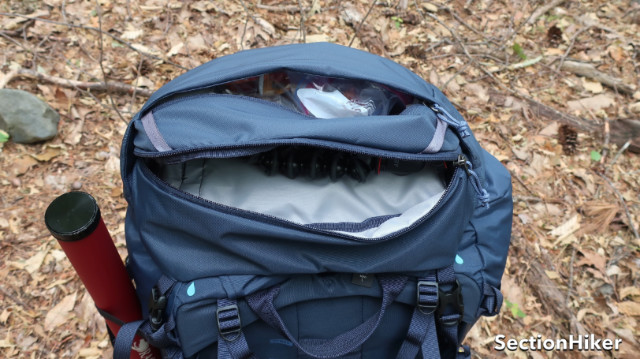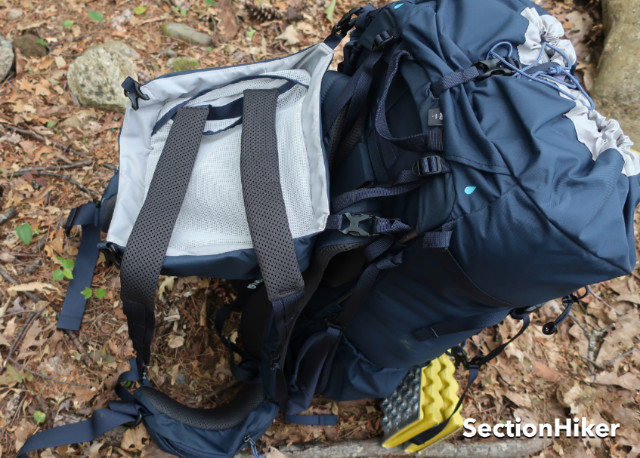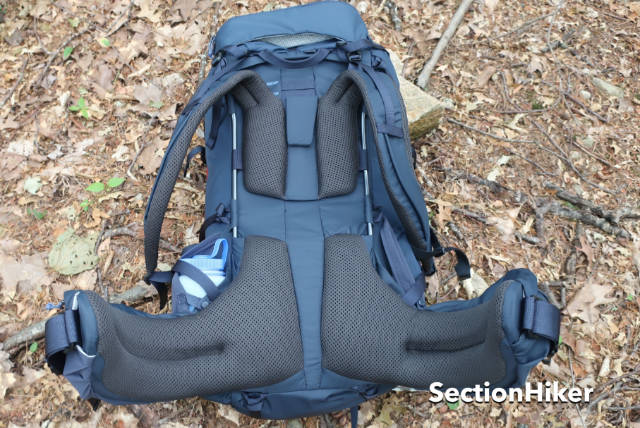
The REI Traverse 60 is a fully-featured multi-day backpack with an adjustable torso length, so you can dial in a personalized fit. It has loads of pockets and reconfigurable attachment points that make it suitable for year-round adventures with a feature set that’s highly competitive with other brand-name backpacks. Weighing 4 lbs 4 oz, it’s available in men’s and women’s models at a very competitive price.
Specs at a Glance
- Frame: Internal
- Adjustable Torso: Yes
- Access: Top and sleeping bag compartment
- Weight: 4 lbs 4 oz (size medium)
- Pockets: 10 + main
- Load lifters: Yes
- Hydration compatible: Yes
- Rain cover included: Yes
- Removable day pack: Yes
- Bear canister compatibility: all bear vault sizes fit horizontally.
- Torso range: 19-21″ (multiple sizes avail. from 17″-21″)
- Hip belt sizing: 36-46″ (multiple sizes avail from 32-46″)
- Max recommended load: 35 lbs
Backpack Storage and Organization

The REI Traverse 60 has a conventional backpack design with a floating top lid, side water bottle pockets, side gear pockets, an open front pocket, two hip belt pockets, and a rain cover pocket, in addition to the main compartment. It can be accessed from the top under the lid or from the bottom through a hatch leading to an optional sleeping bag compartment. All of the external pockets have solid external faces for added durability in addition to drainage ports to prevent the seams from leaking in the rain.

The top lid has a large external pocket on top and a large mesh pocket on the underside. The mesh pocket contains two shoulder straps that can be joined to the lid’s external buckles to form a summit pack if you wish to leave the rest of your gear behind for quick side trips.

The traverse has two pairs of side pockets: elasticated stretch pockets for holding water bottles and another pair below the side compression straps for strapping gear to the side of the pack, such as tent poles or fishing tods. I’ve seen this design used on other REI packs in the past and it is unique in the industry. While it does add some weight, splitting the two functions, gear storage and bottle storage, makes a world of sense. A rain cover is stored in another small pocket underneath one these side gear pockets.
There’s an open front pocket on the outside of the main compartment for storing wet gear or layers. The sides of the pocket are made with stretchy lycra to help accommodate oversized or oddly shaped items and provide drainage. The top of the pocket is also secured with a webbing strap and buckle to prevent items from falling out.
The main compartment has an internal hydration pocket and a hang loop to hold a reservoir, with left and right side ports above the shoulder straps to run a hydration hose.

The hip belt pockets are quite large and are long enough to fit hiking trail maps. One of the pockets is faced with highly stretchable, but non-mesh solid fabric, while the other is faced with the same 300d ripstop nylon used elsewhere on the pack. I think these hip belt pockets are the largest ones I’ve ever seen on a backpack including the Osprey Atmos 65, which we reviewed recently.
Backpack Frame and Suspension

The REI Traverse 60 is an internal frame backpack that consists of an inverted U-shaped metal rod that slots into the hip belt to transfer load to your hips. There’s also a horizontal stay part way down the inverted “U” to prevent the back of the pack from barreling into your back if you have to carry a hard curved object like a bear canister inside.
The Traverse 60 has an adjustable torso length so you can lengthen or shorten the distance between the hip belt and the shoulder pads in order to dial in a good fit. Unfortunately, the adjustments can only be made in 1-inch increments from 19″-21″, which is valuable, but not as optimal as packs where you can position the shoulder yoke anywhere up and down the frame if your size falls in between the torso lengths available.
The adjustment mechanism is very simple and requires sliding a velcro tab through webbing straps on the back panel before locking it in place at the required torso length. The positions of the webbing straps are labeled in inches, which is nice, since most adjustable packs are unlabelled, particularly those intended for international markets where sizing is not based on the metric system and not on imperial units.

The back of the shoulder straps and the hip belt are heavily padded and covered with breathable mesh where they come in contact with your shoulder blades and the back of your hips. While the pack does not have a ventilated suspended mesh back panel there are ventilation channels where air can flow through the padding to help keep you cooler. Deuter backpacks tend to use a similar padding configuration.

The shoulder straps on the men’s model are J-shaped and well padded with a rail-based sternum strap that is easy to reposition higher or lower along the shoulder straps. Unfortunately, the plastic fittings at the ends of the sternum strap come off when tension is placed on them How much tension? They come off as soon as you try to reposition the sternum strap up or down or when you tension it. When that occurs, it’s virtually impossible to get them back on back on, rendering the sternum strap, and consequently the backpack, unusable.

While a sternum strap is not load-bearing, it is essential for keeping the shoulder straps positioned on your shoulders, which do carry some load. Without a functioning sternum strap, a backpack becomes uncomfortable and unstable to carry. You can work around it by replacing the backpack sternum strap with one of your own and it can be as simple as a long velcro strap pinned to one of the should straps. While this can be awkward, it will work.
Finally, the hip belt is quite wide and pre-curved, providing excellent load transfer to the hips. The hip belt has a beefy center buckle which makes the pack easier to use in winter when wearing gloves and pull-forward webbing straps, so you can get a nice snug fit without much effort. One tightened it stays put and the extra padding keeps it positioned on your iliac crest.
External Attachments and Compression

The Traverse 60 really excels when it comes to external attachment points, so you can lash bulky gear to the outside of the pack and easily reconfigure it as needed for different adventures. While most backpacks of this size have two tiers of side compression straps (4 straps in total) that are fixed in their location and orientation, the Traverse 60 comes with 6 straps and 10 buckles that can be repositioned where you need them around the perimeter of the pack. The straps and buckles are girth hitched to the webbing loops positioned along the sides and base of the pack, so you remove them or reposition them any way you want.

What’s a girth hitch? It’s a very simple way of attaching a line with a loop at one end to a fixed loop. The video below demonstrates this.
You can attach just about anything from snowshoes and skis to sleeping pads or tent bodies to the pack with these straps and buckles. It’s a great system that’s really flexible to use. I wish all backpack compression systems were built like this. It really is best-in-class.
Comparison Table
Comparison of the Traverse 60 with other backpacks that we recommend in this weight/volume bracket.
| Make and Model | Weight | Access |
|---|---|---|
| Gregory Baltoro 65 | 4 lbs 14.4. oz | Top, front, bottom |
| Gregory Baltoro 75 | 4 lbs 15.7 oz | Top, front, bottom |
| Gregory Katmai 65 | 4 lbs 11.8 oz | Top, bottom, side |
| Gregory Paragon 68 | 3 lbs 11 oz | Top, bottom, side |
| Mountain Hardwear AMG 75 | 4 lbs 15.4 oz | Top |
| Osprey Aether 65 | 4 lbs 14.7 oz | Top, front, bottom |
| Osprey Aether Plus 70 | 5 lbs 8 oz | Top, front, bottom |
| Osprey Aether Pro 70 | 3 lbs 15 oz | Top |
| Osprey Atmos AG 65 | 4 lb. 9 oz | Top, bottom, 2 sides |
| REI Trailbreak 60 | 3 lbs 13 oz | Top, bottom |
Assessment
The REI Traverse 60 would be an exceptional value if it had a sternum strap that was reliable, easily fixed, or could be easily replaced with a convenient alternative The problem is that the plastic fittings that slide down the rails on the shoulder straps can come off under tension. Getting the plastic fitting reseated is very very difficult and while it may not come off every Traverse 60 backpack sold, it’s not something you want to happen in the middle of a multi-day backpacking trip, since it may blow the trip.
Other than this one issue, the Traverse 60 is a great multi-day internal frame backpacking pack that has plenty of storage and pockets to organize your overnight backpacking gear. It’s durably made with 300d recycled ripstop nylon and has an adjustable length torso, so you get a more precise fit than most fixed-length backpacks. The Traverse 60 is also available in four sizes, including long hip belt lengths which makes it accessible to people of all shapes and sizes.
But the thing that makes the Traverse 60 unique is the ability to move around the compression straps (REI calls them Pack Mod straps, also sold separately, so you can attach all kinds of gear to the exterior of the pack. That is a really great idea that makes the Traverse 60 an exceptional value and distinguishes it from other packs from the likes of Osprey, Gregory, and Deuter.
It’s ironic that REI didn’t use the packmod concept to implement the sternum strap on the Traverse 60. That would have avoided this entire issue.
Disclosure: REI donated this backpack for review
Compare 3 Prices
-

 Amazon US$147.94View
Amazon US$147.94ViewAmazon.com Price: $147.94 (as of 04/23/2024 21:07 GMT-0400) Details
Product prices and availability are accurate as of the date/time indicated and are subject to change. Any price and availability information displayed on Amazon.com at the time of purchase will apply to the purchase of this product.
-
 REI$259.00View
REI$259.00View -
 REI$259.00View
REI$259.00View
 SectionHiker.com Backpacking Gear Reviews and FAQs
SectionHiker.com Backpacking Gear Reviews and FAQs 

I hade the same problem with that pack. Sternum strap wouldn’t stay attached. I returned it and got an Osprey.
What’s strange is that design for the sternum strap is something Osprey uses on at least some of its packs as well – though clearly they execute it better.
I know a half dozen other pack manufacturers that use the same design and pull it off successfully. This isn’t rocket science. The brilliant person who designed this pack is probably really pissed off about this manufacturing and quality flaw.
Apparently *many* other customers have experienced the same issue. Like I said, I have no idea why they continue to sell this pack and haven’t pulled their stock to fix it. It’s a damn shame. Not the behavior that I normally associate with REI. You shouldn’t have to return a backpack for something this stupid.
10-4. I looked into the dates of the bad reviews and they go from early on til the present. That convinced me to take it off the list of possible future choices for a sturdy pack in the 65 liter range.
I appreciate that Philip pointed out all the good things on this pack, but used candor for the flaw. I have had same exact issue with an Osprey and a Gregory a few years ago (Osprey told me to pry the clips jaws open with a flatblade screw driver so it could pop over the keeper rope slide. I got it back on after a few tries but it was not easy. Did the same on a Gregory successfully). I think that whole configuration is flawed. The clip slide part should be aluminum, not plastic. The plastic is too easily deformed by pressure – why it pops off.
I own an REI Flash 55 men’s backpack and had exactly this problem with the sternum strap since my second trip with the pack. This pack fits me so well I’m going to put up with fixing the strap every other day. The Flash sternum strap is not difficult to fix but I don’t own the Traverse 60 so I’m not sure if it is as easy to fix as the Flash model.
It is very difficult to fix the sternum strap on the Traverse 60. I just use a velcro strap instead. Not really optimal.